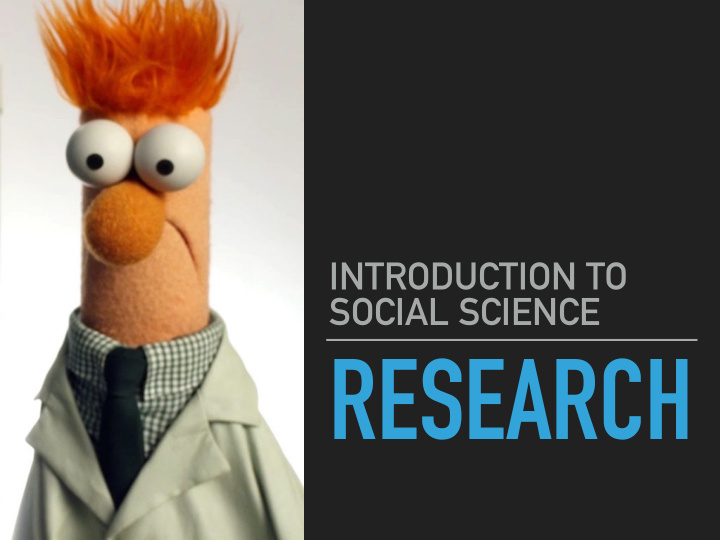



INTRODUCTION TO SOCIAL SCIENCE RESEARCH
THE SCIENTIFIC STUDY OF HUMAN SOCIETY AND SOCIAL RELATIONSHIPS social science
SOCIAL SCIENCE RESEARCH METHODS ▸ Observational, archival, or case study ▸ Surveys, interviews ▸ Experimental research
RESEARCH ETHICS
RESEARCH ETHICS ▸ Respect for persons: recognition of the personal dignity and autonomy of individuals, special protection of those persons with diminished autonomy. ▸ Beneficence: obligation to protect persons from harm by maximizing anticipated benefits and minimizing possible risks of harm. ▸ Justice: requires that the benefits and burdens of research be distributed fairly.
RESEARCH ETHICS ▸ Example: ▸ Milgram
BIASES IN SCIENCE
BIASES IN SCIENCE ▸ Confirmation bias ▸ Ignoring evidence that contradicts what we believe
BIASES IN SCIENCE privileged white adults with expertise in robotics ▸ What robot would people most like to be?
RESEARCH QUESTION
RESEARCH QUESTION ▸ Thesis statement = answer to the research question. ▸ “Why do people like robots?” ▸ Too broad! ▸ Better: “Does naming a Roomba make people anthropomorphize it more?” ▸ Are you biased?
A STATEMENT ASSUMED TO BE TRUE FOR THE PURPOSE OF TESTING ITS VALIDITY. Hypothesis
HYPOTHESIS ▸ If we make certain observations under particular conditions, and a particular theory is correct, then we should find the following results. ▸ Capable of empirical testing ▸ Capable of empirical confirmation or disconfirmation
HYPOTHESIS EXAMPLE ▸ If the Roomba is introduced with a name, participants will rate it as more anthropomorphic than when it is not.
ASPECT OF A TESTING CONDITION THAT CAN CHANGE WITH DIFFERENT CONDITIONS Variable
VARIABLES ▸ Representative of the concepts you’re trying to measure ▸ Independent/dependent ▸ Confounded
HOW WELL DOES THE RESEARCH CONCLUSION CORRESPOND WITH REALITY? Validity
VALIDITY ▸ Internal Validity ▸ Is there really a cause and effect relationship between the independent and dependent variables? ▸ Confounded variables
VALIDITY ▸ Construct Validity ▸ Can we generalize from the specific things we’re measuring to the research question? ▸ “Do people empathize with cute robots?” -> You need solid ways of measuring empathy and cuteness.
VALIDITY ▸ External Validity ▸ Are the findings generalizable? privileged white adults with expertise in robotics
WHAT TO BE CAREFUL OF WHEN DESIGNING AN EXPERIMENT ▸ Biases ▸ Ethics in human subject research ▸ Focused research question & hypothesis ▸ Internal validity: Defining your variables and holding other variables constant ▸ Construct validity: Are you measuring what you intend to measure? ▸ External validity: Generalizability of results?
Recommend
More recommend